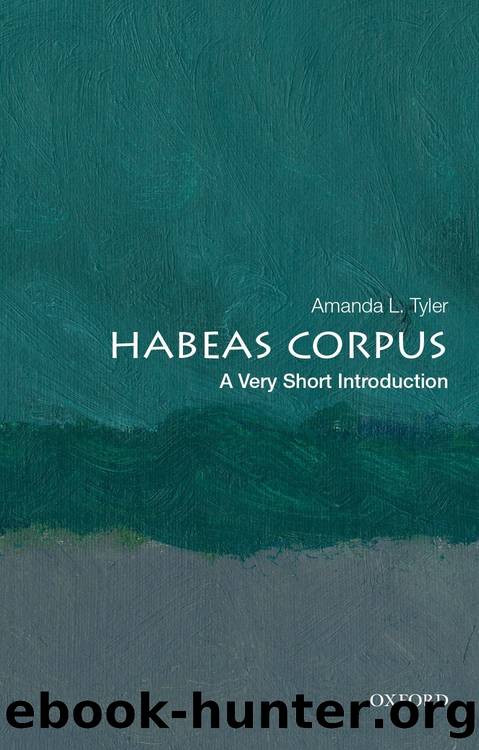Habeas Corpus: A Very Short Introduction by Amanda L. Tyler

Author:Amanda L. Tyler [Tyler, Amanda L.]
Language: eng
Format: epub
Tags: law, General, Constitutional, Judicial Power, Military, history, World
ISBN: 9780190919009
Google: Am4sEAAAQBAJ
Publisher: Oxford University Press
Published: 2020-12-01T00:30:21.069551+00:00
The American experience during the war
In the immediate wake of the attack on Pearl Harbor, Hawaiian territorial governor Joseph Poindexter declared a suspension of habeas corpus and proclaimed martial law on the islands. To do so, he invoked the Hawaiian Organic Act of 1900, which delegated to the governor standing authority to suspend the privilege âin case of rebellion or invasion, or imminent danger thereof, when the public safety requires it,â along with the power to âplace the Territory, or any part thereof, under martial law.â Under the act, any suspension or declaration of martial law would remain in effect âuntil communication [could] be had with the President and his decision thereon made known.â President Roosevelt quickly approved the governorâs actions, and this state of affairs on the islands governed through much of the war.
Following the governorâs proclamation, the military took over all governmental affairs in Hawaii, including the courts, and eliminated trial by jury while declaring that all criminal trials be conducted by military tribunals. The latter practice continued even after civilian courts reopened later in the war to hear noncriminal matters. Under the auspices of the suspension, the military arrested citizens suspected of disloyalty and detained them without formal hearings and without criminal charges. The military also issued orders prohibiting the filing or even acceptance by a judge of a petition for a writ of habeas corpus.
Nonetheless, the US District Court for the territory of Hawaii decided several notable habeas cases during the war. It did so in two contexts: first, challenges to arrests and detentions for so-called subversive activities; and second, challenges to military criminal trials. In both contexts, habeas petitioners argued that the militaryâs exercise of emergency powers transgressed the Constitution, the Hawaiian Organic Act, or both. After the war, the Supreme Court reviewed many of these actions in Duncan v. Kahanamoku (1946) and held unlawful the governmentâs declaration of martial law in the Hawaiian Islands, ultimately vacating the convictions of two civilians who had been tried by a military commission for embezzlement and assault. (Notably, the decision was grounded in an interpretation of the Hawaiian Organic Act, although the Constitution loomed large over the majority opinion written by Justice Hugo Black.)
The story on the mainland in the United States was very different, though it led to similar results. There, Congress never debated, much less passed, any suspension legislation. Instead, military orders carrying out President Franklin Delano Rooseveltâs infamous Executive Order 9066 governed the treatment of those suspected of potential disloyalty. Executive Order 9066, which President Roosevelt issued on February 19, 1942âten weeks after the Japanese attack on Pearl Harborâauthorized the secretary of war to designate military zones âfrom which any or all persons may be excludedâ and regulate the terms by which persons could enter, remain in, or be forced to leave such areas. By its own terms, 9066 included no language specifically targeting a particular group. Nor did the order expressly mention detention, but it did authorize the secretary of war âto provide for
Download
This site does not store any files on its server. We only index and link to content provided by other sites. Please contact the content providers to delete copyright contents if any and email us, we'll remove relevant links or contents immediately.
| Africa | Americas |
| Arctic & Antarctica | Asia |
| Australia & Oceania | Europe |
| Middle East | Russia |
| United States | World |
| Ancient Civilizations | Military |
| Historical Study & Educational Resources |
Never by Ken Follett(2880)
The Man Who Died Twice by Richard Osman(2299)
Machine Learning at Scale with H2O by Gregory Keys | David Whiting(2291)
Fairy Tale by Stephen King(2070)
Will by Will Smith(2042)
Rationality by Steven Pinker(1765)
The Dawn of Everything: A New History of Humanity by David Graeber & David Wengrow(1571)
The Dark Hours by Michael Connelly(1570)
Principles for Dealing With the Changing World Order: Why Nations Succeed and Fail by Ray Dalio(1373)
Friends, Lovers, and the Big Terrible Thing by Matthew Perry(1328)
A Short History of War by Jeremy Black(1300)
HBR's 10 Must Reads 2022 by Harvard Business Review(1256)
Go Tell the Bees That I Am Gone by Diana Gabaldon(1234)
Can't Hurt Me: Master Your Mind and Defy the Odds - Clean Edition by David Goggins(1227)
515945210 by Unknown(1208)
Fear No Evil by James Patterson(1109)
443319537 by Unknown(1072)
Works by Richard Wright(1018)
Going There by Katie Couric(991)
